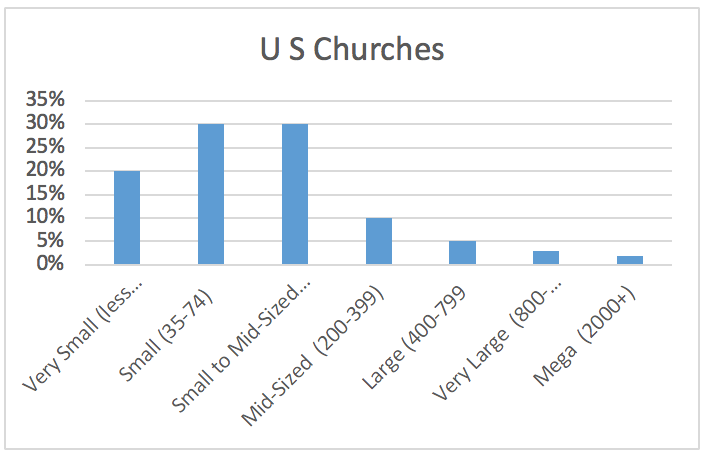by Franklin Dumond, Director of Congregational Ministries
Anyone who studies the local church in the United States quickly recognizes that churches come in all shapes and sizes. Business franchises and fast-food chains look and function identically no matter where they are located. Local churches, however, are not carbon copies of one another.
While no two churches are exactly the same, a functional sameness often exists among churches of similar size. This generally means that similar-sized churches of different denominations function very much alike. This is especially noticeable in regard to the ways similar-sized churches reach out to new people and include them in the congregation. Understanding these similarities can help local churches understand their growth patterns and plan future outreach strategies.

Gary McIntosh, in his book One Size Doesn’t Fit All, uses a simple grouping of three types of churches to help explain many of these similarities. He identifies small, medium, and large-sized churches based on their average attendance. He further identifies them as a single cell, stretched cells, or multiple cells in their organization.
In a small church, everyone knows everyone else. They form a single cell. Often the common bond that links them is kinship. It is not uncommon for a small church to be composed of members from two or three extended families. These key families provide all the leadership and organization for the church’s ministry. The small church will generally be 50 or fewer in size but can easily extend to 100-150 depending on the relationships that exist within the group. For example, if an extended family that includes several generations also includes several larger families, the ‘small’ church when measured by attendance will look more like a medium-size church. Nevertheless, when measured by who are the leaders, and how close the personal relationships are, the church will qualify as a small or single-cell church.
In a medium-size church, there may be too many people for everyone to know everyone else. Often a kind of stretched cell exists where a variety of programs and ministries exist, but leaders for those programs and ministries only come from a small group of long-term members. These long term members are themselves very likely to share kinship as part of an extended family that is embedded within the congregation. A medium-sized church will generally have 100-150 in attendance but may extend to 200, 300, or even 400 depending on the expertise, leadership, and energy level of the pastor and key lay leaders.
In a large church, there are too many people for everyone to know everyone else. With numerous groups and ministries where people can become involved, the large church becomes a congregation of congregations with leadership drawn from several groups, classes, or cells. Often the large church will be staff directed or will at least have a formal board or elder structure with clarified leadership roles and terms of service. The large church will generally have 400-800 in average attendance but can include those churches of 800-2000 who are organized in similar fashions. Organizationally, the larger church of 800+ must change to take on the structures of the mega-church of 2,000+ if it is to maintain its level of operation.
A review of the number of churches in the United States shows that the median size of a US church is 75. This means that 50% of all churches have 75 or fewer in average attendance while 50% also have 76 or more in average attendance according to the National Congregations Study by Duke University. George Barna’s research also discovered that 60% of churches have 100 or fewer in attendance.
Whether large or small, churches exist to proclaim the gospel and to advance the Kingdom. But does the large church grow in the same way the small church does? Will the outreach strategy for a very large church be the same as that of a very small church? Significant frustration surfaces when a style or method of outreach that is appropriate for one size church is attempted in another size church setting. This does not mean that churches do not want to grow. It does mean that different churches will grow differently.
While the specific strategy for a local church must be customized for that local church, there are principles that will guide churches in their growth. Here are three principles that provide a foundation for growth in any size church.
- Understand who you are as a church. Are you a small church that features close, personal, family-type connections? Are you a middle-sized church with a capable pastor who recruits and inspires key leaders? Are you a large church with an above-average communicator as Lead Pastor and a stellar worship team that attracts crowds?
- Determine what it is that you do best and then do it often! Build on your strengths.
- Identify existing programming to find those ministries that need improvement. Begin to correct weaknesses one or two at a time.
These principles provide a foundation for outreach and growth.
